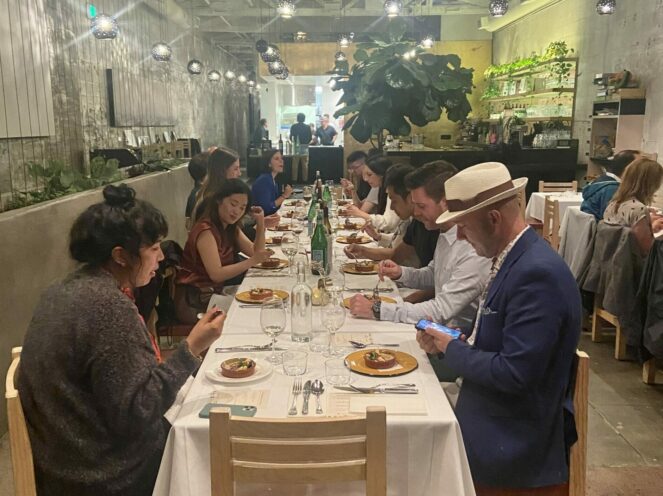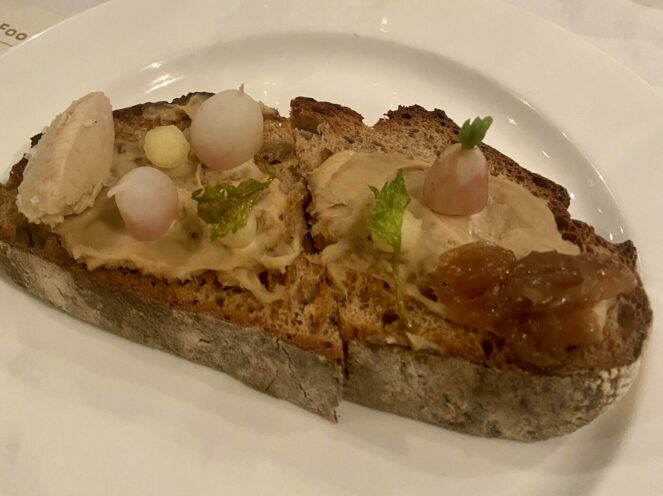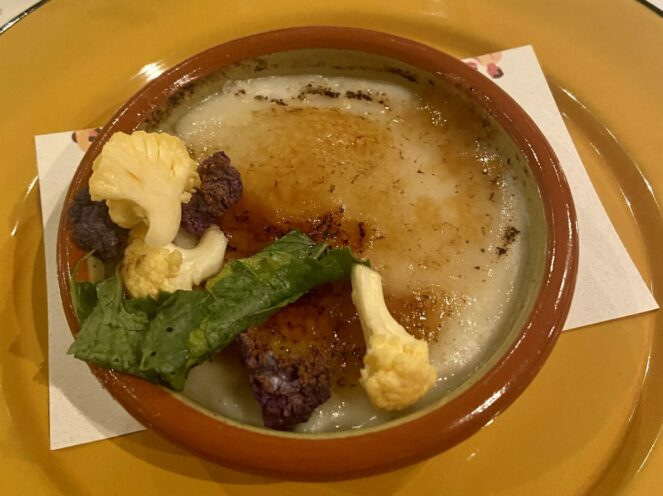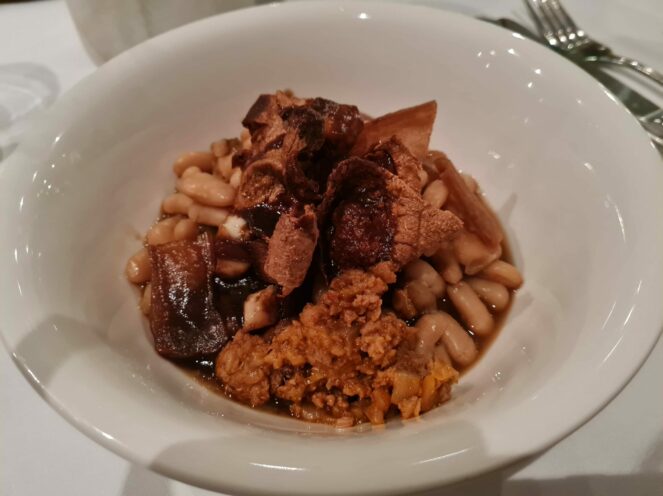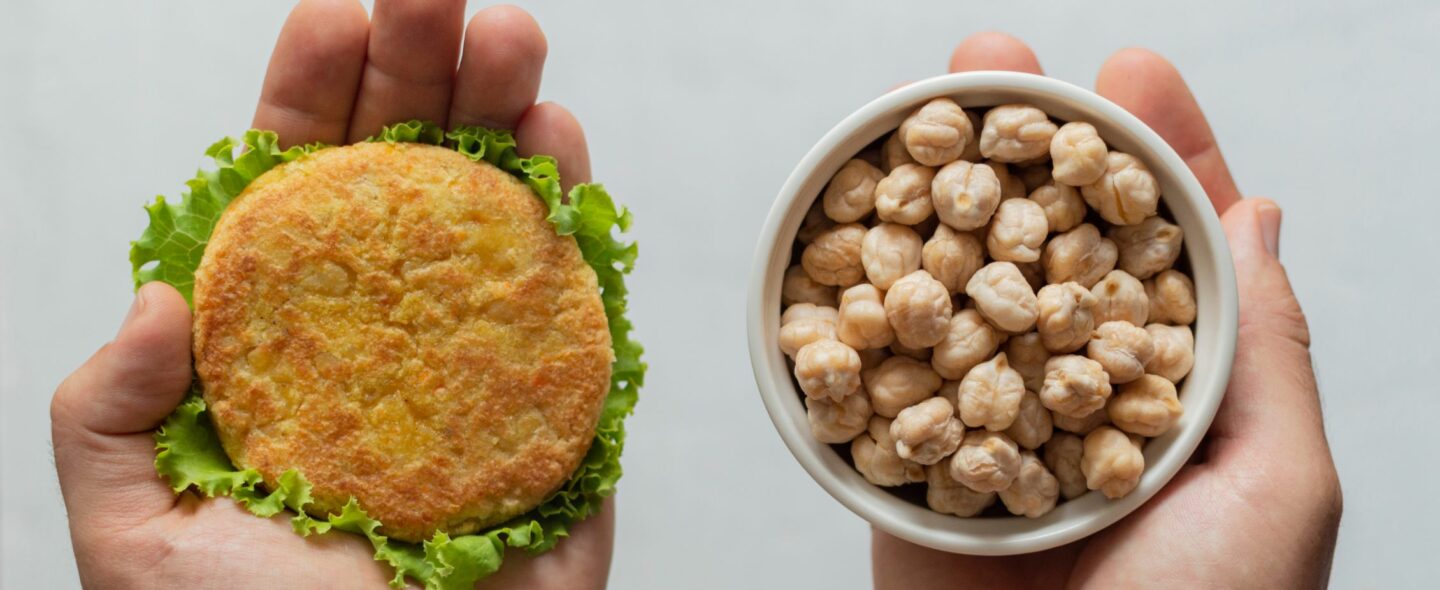
Published February 9, 2023
Crises such as the Russian invasion of Ukraine and the Covid-19 pandemic can destabilize the global food system and prompt us to rethink how the world feeds its 8 billion (and increasing) inhabitants. It has become clear that we must change how we produce and consume food.
Big problems demand creative and bold solutions. For that reason, Swissnex in San Francisco, in collaboration with Farming Hope, convened innovators, thinkers, advocates, and visionaries from Switzerland and the Bay Area who care about a resilient food system. Attendees included Bay Area experts and innovators, but also representatives from Swiss food companies Hilcona and Coop, who were visiting San Francisco to learn about the future of plant-based food.
While enjoying a 4-course tasting menu, each containing an element of food resilience, we discussed the challenges our current food system faces during moments of crisis and explored ways to collaborate and build on each other’s solutions with the goal to contribute to a more resilient food future.
Food Resilience
A resilient food system is one that «is able to withstand and recover from disruptions in a way that ensures a sufficient supply of acceptable and accessible food for all» (Source: John Hopkins Center for a Livable Future). In light of recent supply chain disruptions caused by crises and climate change, food resilience has become more important than ever. To overcome food insecurity, we need to foster food systems that build on existing resources, are equitable for the long term, and are prepared for future disruptive events.
The causes of food insecurity are diverse, but animal protein production has a significant adverse effect on climate-change and making supply chains less resilient. To address this, the Bay Area ecosystem has seen a growth of companies around meat or dairy substitute products and corresponding technologies.
Plant-based Meat Alternatives
Plant-based meat alternatives create the experience of eating animal products minus the harms associated with traditional livestock practices. These innovative products make enjoying meat-based dishes more climate-friendly and resource-efficient, ideally without demanding major taste sacrifices from consumers. There are many examples of such alternatives and the tasting dinner exposed attendees to a delicious variety. The company Umaro, for example, developed meaty bacon by using red, ocean-farmed seaweed as a sustainable protein source to bypass the environment-harming animal protein production. Another startup, Karana, makes meat alternatives from jackfruit, with textures incredibly close to real ground meat.
As of now, the major obstacles with plant-based meat alternatives are taste and price. But with further research, these alternative products can be made comparable to animal-based products on both fronts. According to San Francisco based startup Lypid, fat is the key to make vegan meat taste like real meat. Given this background, the food-tech startup developed an alternative fat that accurately mimics the texture, mouthfeel, transfer of flavor, and cooking behavior of animal fats.
Sundial Foods also intends to make plant-based food more nutritious, sustainable, and affordable. After years of research and development, the startup’s technology only uses eight simple ingredients to create high-protein plant-based chicken wings. A large-scale shift from animal products to alternative protein technologies has tremendous potential food security and climate benefits.
And last but not least, it is not just about mimicking meat, but also about harnessing the power, taste, and nutrition provided by plants. Nectariss’ patented technology allows them to release the aromatic potential of truffles through fermentation and thus supply the market with authentic truffle flavors the whole year round. The Better Meat Co. also harnesses fermentation to make mycoprotein ingredients that food companies can use as the basis of their blended and fully animal-free meats. Their technology is based on mycelium, the root system of fungi, which has a structure that mimics the texture of animal meat. This mycelium is then transformed into mycoprotein.
The future of food involves innovative products like the ones we tasted during the food resilience dinner, but is also about optimizing food systems to be truly inclusive of all communities, not just people of a certain disposable income. – Phil Saneski, Culinary Director at Farming Hope
Social Aspect of Food Resilience
On top of the environmental considerations explained above, there are also social aspects to pay attention to. Due to structural inequities, marginalized communities tend to struggle with limited access to good quality food. Our partner Farming Hope addresses this unjust social aspect of the food system in San Francisco directly by providing job opportunities and access to food for the disadvantaged.
The nonprofit’s mission is to empower folks experiencing major barriers to employment to grow and cook food to sustain themselves and their communities. To do so, Farming Hope manages a garden-to-table job training program for community members overcoming obstacles such as former incarceration or homelessness. The program thereby combines lasting social change with feeding food-insecure neighbors and rescuing food from landfill.
The example of Farming Hope shows that, as many other sectors, the food industry is also starting to embrace circular economy thinking.
Against Food Waste
Food goes to waste at every stage of food production, distribution, and consumption. From farmers, packers, suppliers, retailers to our homes. In the United States, food waste is estimated at between 30-40 percent of the food supply. This amounts to 108 billion pounds of food, 130 billion meals, and more than 408 billion US-dollar each year. In other words, that’s enough to feed all children in the United States and Canada three times a day for an entire year. And still have leftovers.
Food rescue, or food recovery, describes the practice of rescuing high-quality food that would otherwise go to waste and distributing it to people in need.
Farming Hope works with like-minded community organizations to alleviate the financial burden of feeding a family and removing food insecurity. For the Community Meals program, they source cosmetically imperfect products through their network of farmers and suppliers. The creative culinary team then uses the recovered products in their entirety, including any byproducts to prepare healthy, flexible menus and counteract food waste.
Upcycling
Beyond just reducing waste, there lies great potential in reusing and upcycling the resources we already have. Upcycling refers to the process of transforming by- and waste-products into new products, which are of higher value or quality.
The upcycling aspect of food resilience has been covered by Voyage Foods. The company uses waste products from wine production, specifically grape seeds, to create alternatives that taste just like the original product. One of their products we were able to taste during the sustainable food dinner was their nut-free peanut butter. That’s no nuts!
I perceived the event at Farming Hope a bit as a glimpse into the future, or one possible future, illustrating what sustainable eating might become. The dinner also highlighted two important points: current meat substitutes still have a long way to go in terms of taste and texture to efficiently replace actual meat, but a skilled chef can also do magic in terms of taste/flavor. – Richard Splivallo, CEO of Nectariss Sàrl
We Need Food that Is Future-proof, Not Futuristic
As the world’s population grows and climate change will continue to cause droughts, heat waves, and other extreme weather events, there is an urgent need for changes within our food system to become future-proof. Such changes will be driven by new modes and methods of technology along the supply chain.
So, what’s next? Beyond expanding on the promising solutions we were able to taste during the event, upcoming technology solutions are cultivated meat and hybrid products. Cultivated meat is genuine animal meat but produced by cultivating animal cells. Hybrid meat on the other hand, includes both meat and plant-based ingredients such as vegetables, plant proteins, mushrooms, or seeds. Both production methods conserve animal resources.
Another lesson learned is the need to align actions across different sectors, such as food, energy, and transportation. Our dinner around food resilience has been a real taste experience and more so, opened new doors for collaboration across startups and sectors.
Thank you everyone who contributed to this unique experience, and stay foodie!
Edited and written by Sophia Burri (Communications Associate) with input by Corine Thommen (Head of Impact Programs).
Taste Experience
The 4-course tasting menu, each containing an element of food resilience.
